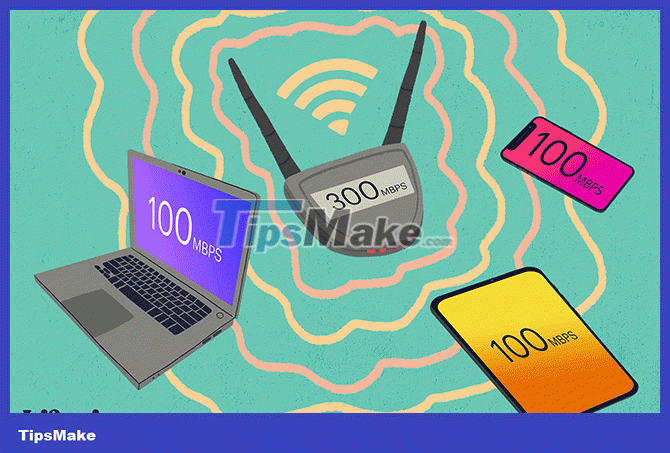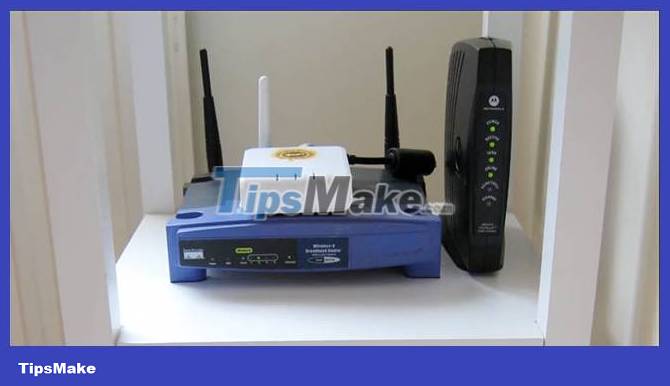How many devices can a wireless router allow to connect?
Computers and other devices on the network share finite resource capacity, which is true for both wired and wireless (WiFi) networks. When you connect your laptop, PC, and smartphones to the network, it becomes more difficult to stream Netflix or Hulu on your TV. That's because when more devices connect to the network, it takes up more bandwidth.
The router will automatically determine where it needs the most capacity and network usage. It then optionally adjusts the network to keep all devices operating at a suitable level.
How many devices can connect to one router?
Most home networks and public WiFi hotspots work with a single wireless access point (a broadband router in the case of a home network connection). In contrast, enterprise computer networks install multiple access points to expand wireless network coverage to a larger area.
Each access point has a limit to the number of connections and the amount of network load it can handle. By integrating multiple access points into a larger network, the overall scale is increased.

Theoretical limit of WiFi network size
Many individual wireless routers and other access points can support up to approximately 250 connected devices.
Important : The speeds of access points represent the maximum (theoretical) network bandwidth that each point can support. For example, a WiFi router rated at 300Mbps with 100 devices connected, can only provide an average of 3Mbps per device (300/100 = 3).
If you're not sure what your router can support, try searching for more information on the internet based on the device's model number.
Most people only use a network connection occasionally, and a router transfers available bandwidth to devices that need it. Those changes depend on what a particular device needs at a particular time.
The practical limits of WiFi network expansion
Most people don't come close to the maximum number of devices a typical router can allow for connection. That's a good thing, because connecting 250 devices to a single WiFi access point is (in theory) impractical for a few reasons.
Administrators often maintain limits to keep the router and network running smoothly.
On a home network, all devices usually share one Internet connection. Performance decreases when more devices join the network and use it simultaneously. Even just a few devices actively streaming video or downloading files can quickly take over a shared Internet link.
Access points will overheat and shut down when operating at very high loads for long periods of time, even when only handling local traffic and not accessing the Internet.
A large number of WiFi devices are concentrated in close locations, such as homes or office buildings, creating wireless signal interference. Radio interference between WiFi devices reduces network performance (due to frequent rebroadcasting of messages that do not reach their destination) and ultimately causes connection problems.
Some home routers include a feature that allows administrators to control the number of clients (clients) that can connect simultaneously. For example, many Linksys routers set a default maximum of 50 devices.
How to maximize network potential

Installing a second router or access point on the home network can help distribute the network load. By adding more access points to the network, any number of devices can be supported. However, this makes network management gradually more difficult.
Another thing you can do, if you have one or more routers that support a large number of devices, is to increase the available bandwidth for each simultaneously connected device by upgrading your subscription with your ISP. For example, if network devices and Internet subscriptions download at 1Gbps, connecting 50 devices at once allows each device to use up to 20 megabits of data per second.
Some people use mesh networks to improve wireless network coverage in the home. These networks provide better coverage because they consist of 'nested' routers that provide Internet coverage over a large area, something that most traditional single router networks cannot provide. .
See more:
You should read it
- How to Set Up a Wireless Router
- Which type of wireless router has the longest range?
- 'Great' to speed up Wifi to Wireless Router
- How to set a password for Wireless
- Why need to change the wireless channel of the router?
- How to set up WEP, WPA, WPA2 for Linksys router
- 5 tips to help make optimal use of Tomato on the Router
- Top 5 best Xiaomi WiFi routers
May be interested
- How to Connect 2 Routers to Expand Your Network
 this article shows you how to add a second router to your home or small business network. if you want to add more computers or other devices to your home or small business network but don't have enough ports, try adding a second router. besides expanding the network, a second router is also installed in locations where wi-fi is 'dead' due to weak or non-existent wireless signals.
this article shows you how to add a second router to your home or small business network. if you want to add more computers or other devices to your home or small business network but don't have enough ports, try adding a second router. besides expanding the network, a second router is also installed in locations where wi-fi is 'dead' due to weak or non-existent wireless signals. - How to Make a Regular Printer Wireless with a Wi Fi Router
 today's tipsmake will show you how to turn a regular printer into a wireless printer by connecting the device to a router. if this doesn't work, you can still connect the printer to a computer connected to the internet and share it with other computers on the network.
today's tipsmake will show you how to turn a regular printer into a wireless printer by connecting the device to a router. if this doesn't work, you can still connect the printer to a computer connected to the internet and share it with other computers on the network. - Basic guide: wireless network - Wireless
 this article shows you how to set up or 'tune' your wireless network, then connect more printers, music players, and tvs to this wireless network.
this article shows you how to set up or 'tune' your wireless network, then connect more printers, music players, and tvs to this wireless network. - Which type of wireless router has the longest range?
 different standards - including 802.11b, 802.11g and 802.11n - of both the wireless adapter and access point will affect the maximum range. however, solving certain problems can improve the range of any wireless router.
different standards - including 802.11b, 802.11g and 802.11n - of both the wireless adapter and access point will affect the maximum range. however, solving certain problems can improve the range of any wireless router. - Building a wireless network with a broadband router - Part 2: Configuring the router and computers on the network
 the best way to set up a private network is to use a broadband router. this device will connect all computers in your network and also automatically share your broadband internet connection. in part 1 of this series, we have n & e
the best way to set up a private network is to use a broadband router. this device will connect all computers in your network and also automatically share your broadband internet connection. in part 1 of this series, we have n & e - How to set up VPN on the router
 every time you connect to the internet you have to use a vpn application, so it is very annoying and the phone-based or computer-based application cannot protect the copy from other devices, such as smart tvs or game consoles. so the best method is to install a vpn for the router.
every time you connect to the internet you have to use a vpn application, so it is very annoying and the phone-based or computer-based application cannot protect the copy from other devices, such as smart tvs or game consoles. so the best method is to install a vpn for the router. - How to set a password for Wireless
 setting a password for a wireless device cpnf is called config wireless router. if you buy a good router, there will be documentation and manuals included. from there, you can set the encryption mode, security at your disposal. if in case you don't
setting a password for a wireless device cpnf is called config wireless router. if you buy a good router, there will be documentation and manuals included. from there, you can set the encryption mode, security at your disposal. if in case you don't - Instructions for use and security of Wifi network
 wireless networks are one of the great inventions of the 21st century. instead of using cables to connect computers and devices together, you can now use radio waves to connect. this technology has been widely known as 'wifi'. once set up correctly, wifi will not encounter any problems.
wireless networks are one of the great inventions of the 21st century. instead of using cables to connect computers and devices together, you can now use radio waves to connect. this technology has been widely known as 'wifi'. once set up correctly, wifi will not encounter any problems. - How to Share an Internet Connection
 if you want to share your internet connection with other devices in your home, you're probably wondering how to do it without setting up a complicated network. fortunately, windows and mac computers can easily share their internet connection with other devices. you can turn your computer into a wireless access point without using a router to connect to a wireless device.
if you want to share your internet connection with other devices in your home, you're probably wondering how to do it without setting up a complicated network. fortunately, windows and mac computers can easily share their internet connection with other devices. you can turn your computer into a wireless access point without using a router to connect to a wireless device. - Why need to change the wireless channel of the router?
 the 2.4 and 5ghz wi-fi signal range is divided into a number of smaller strips called wireless channels. each wireless channel translates to a specific radio frequency
the 2.4 and 5ghz wi-fi signal range is divided into a number of smaller strips called wireless channels. each wireless channel translates to a specific radio frequency










 How to turn off SIP ALG on Netgear router
How to turn off SIP ALG on Netgear router How to set up Xiaomi Mi WiFi Router
How to set up Xiaomi Mi WiFi Router 5 steps to enable 5GHz WiFi on TP-Link router
5 steps to enable 5GHz WiFi on TP-Link router What is QoS? How to use QoS to get faster Internet speed when you need it urgently
What is QoS? How to use QoS to get faster Internet speed when you need it urgently Steps to reset WiFi modem
Steps to reset WiFi modem 2 ways to set up TP-Link WiFi 6 . router
2 ways to set up TP-Link WiFi 6 . router